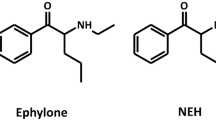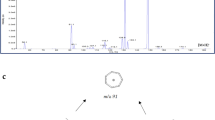Abstract
Purpose
Toxicokinetic studies are essential in clinical and forensic toxicology to understand drug–drug interactions, influence of individual polymorphisms, and elimination routes, as well as to evaluate targets for toxicological screening procedures. N-(2-Methoxybenzyl)-substituted phenethylamines (NBOMe analogues) intake has been associated with severe adverse reactions including deaths. 1-(1-Benzofuran-5-yl)-N-[(2-methoxyphenyl)methyl]propan-2-amine (5-APB-NBOMe), 2-(8-bromo-2,3,6,7-tetrahydrobenzo[1,2-b:4,5-b′]difuran-4-yl)-N-[(5-chloro-2-ethoxyphenyl)methyl]ethan-1-amine (2C-B-FLY-NB2EtO5Cl), and 2-(8-bromo-2,3,6,7-tetrahydrobenzo[1,2-b:4,5-b′]difuran-4-yl)-N-[(2-methoxyphenyl)methyl]ethan-1-amine (2C-B-FLY-NBOMe) are three emerging NBOMe analogues, which have encountered on the drugs of abuse market. So far, their toxicokinetic data are completely unexplored.
Methods
The study included mass spectrometry-based identification of phase I and II metabolites following exposure to the terminally differentiated human hepatocellular carcinoma cells (HepaRG). The determination of enzymes involved in the major phase I/II metabolic steps and determination of plasma protein binding (PPB) were done. Finally, the evaluation of the toxicological detectability by different hyphenated mass spectrometry techniques in standard urine screening approaches (SUSAs) was investigated.
Results
The compounds were extensively metabolized in HepaRG cells mainly via O-dealkylation, hydroxylation, glucuronidation, and combinations thereof. CYP1A2, 2D6, 2C8, 2C19, and 3A4, were involved in the initial reactions of all investigated compounds. Glucuronidation of the phase I metabolites—when observed—was mainly catalyzed by UGT1A9. The PPB of all compounds was determined to be > 85%. Only the high-resolution mass spectrometry-based SUSA allowed detection of all compounds in rat urine, but only via metabolites.
Conclusions
The toxicokinetic data provided by this study will help forensic and clinical toxicologists to reliably identify these substances in case of abuse and/or intoxication and will allow them a thorough risk assessment.






Similar content being viewed by others
References
Evans-Brown M, Sedefov R (2018) Responding to new psychoactive substances in the European Union: early warning, risk assessment, and control measures. Handb Exp Pharmacol 252:3–49
Tettey JNA, Crean C, Ifeagwu SC, Raithelhuber M (2018) Emergence, diversity, and control of new psychoactive substances: a global perspective. Handb Exp Pharmacol 252:51–67
Halberstadt AL (2017) Pharmacology and toxicology of N-benzylphenethylamine (“NBOMe”) hallucinogens. Curr Topic Behav Neurosci 32:283–311
Caspar AT, Brandt SD, Stoever AE, Meyer MR, Maurer HH (2017) Metabolic fate and detectability of the new psychoactive substances 2-(4-bromo-2,5-dimethoxyphenyl)-N-[(2-methoxyphenyl)methyl]ethanamine (25B-NBOMe) and 2-(4-chloro-2,5-dimethoxyphenyl)-N-[(2-methoxyphenyl)methyl]ethanamine (25C-NBOMe) in human and rat urine by GC-MS, LC-MS(n), and LC-HR-MS/MS approaches. J Pharm Biomed Anal 134:158–169
Caspar AT, Helfer AG, Michely JA, Auwarter V, Brandt SD, Meyer MR et al (2015) Studies on the metabolism and toxicological detection of the new psychoactive designer drug 2-(4-iodo-2,5-dimethoxyphenyl)-N-[(2-methoxyphenyl)methyl]ethanamine (25I-NBOMe) in human and rat urine using GC-MS, LC-MS(n), and LC-HR-MS/MS. Anal Bioanal Chem 407:6697–6719
Poklis JL, Dempsey SK, Liu K, Ritter JK, Wolf C, Zhang S et al (2015) Identification of metabolite biomarkers of the designer hallucinogen 25I-NBOMe in mouse hepatic microsomal preparations and human urine samples associated with clinical intoxication. J Anal Toxicol 39:607–616
Poklis JL, Nanco CR, Troendle MM, Wolf CE, Poklis A (2014) Determination of 4-bromo-2,5-dimethoxy-N-[(2-methoxyphenyl)methyl]-benzeneethanamine (25B-NBOMe) in serum and urine by high performance liquid chromatography with tandem mass spectrometry in a case of severe intoxication. Drug Test Anal 6:764–769
Poklis JL, Raso SA, Alford KN, Poklis A, Peace MR (2015) Analysis of 25I-NBOMe, 25B-NBOMe, 25C-NBOMe and other dimethoxyphenyl-N-[(2-methoxyphenyl)methyl]ethanamine derivatives on blotter paper. J Anal Toxicol 39:617–623
Richter LHJ, Flockerzi V, Maurer HH, Meyer MR (2017) Pooled human liver preparations, HepaRG, or HepG2 cell lines for metabolism studies of new psychoactive substances? A study using MDMA, MDBD, butylone, MDPPP, MDPV, MDPB, 5-MAPB, and 5-API as examples. J Pharm Biomed Anal 143:32–42
Caspar AT, Meyer MR, Maurer HH (2018) Human cytochrome P450 kinetic studies on six N-2-methoxybenzyl (NBOMe)-derived new psychoactive substances using the substrate depletion approach. Toxicol Lett 285:1–8
Ameline A, Farrugia A, Raul JS, Kintz P (2017) Retrospective demonstration of 25I-NBOMe acute poisoning using hair analysis. Curr Pharm Biotechnol 18:786–790
Rose SR, Poklis JL, Poklis A (2013) A case of 25I-NBOMe (25-I) intoxication: a new potent 5-HT2A agonist designer drug. Clin Toxicol (Phila) 51:174–177
Eshleman AJ, Wolfrum KM, Reed JF, Kim SO, Johnson RA, Janowsky A (2018) Neurochemical pharmacology of psychoactive substituted N-benzylphenethylamines: High potency agonists at 5-HT2A receptors. Biochem Pharmacol 158:27–34
Heim R (2003) Synthese und Pharmakologie potenter 5-HT2A-Rezeptoragonisten mit N-2-Methoxybenzyl-Partialstruktur. Entwicklung eines neuen Struktur-Wirkungskonzepts. Freie Universität Berlin, Germany.Ph.D. dissertation
Monte AP, Marona-Lewicka D, Parker MA, Wainscott DB, Nelson DL, Nichols DE (1996) Dihydrobenzofuran analogues of hallucinogens. 3. Models of 4-substituted (2,5-dimethoxyphenyl)alkylamine derivatives with rigidified methoxy groups. J Med Chem 39:2953–2961
Halberstadt AL, Chatha M, Stratford A, Grill M, Brandt SD (2019) Comparison of the behavioral responses induced by phenylalkylamine hallucinogens and their tetrahydrobenzodifuran (“FLY”) and benzodifuran (“DragonFLY”) analogs. Neuropharmacology 144:368–376
EMCDDA (2007) EMCDDA–Europol 2007 Annual Report on the implementation of Council Decision 2005/387/JHA. In accordance with Article 10 of Council Decision 2005/387/JHA on information exchange, risk assessment and control of new psychoactive substances. EMCDDA, Lisbon. http://www.emcdda.europa.eu/system/files/publications/503/2007_Implementation_report_281403.pdf. Accessed 22 Aug 2019
Noble C, Holm NB, Mardal M, Linnet K (2018) Bromo-dragonfly, a psychoactive benzodifuran, is resistant to hepatic metabolism and potently inhibits monoamine oxidase A. Toxicol Lett 295:397–407
Ettrup A, Hansen M, Santini MA, Paine J, Gillings N, Palner M et al (2011) Radiosynthesis and in vivo evaluation of a series of substituted 11C-phenethylamines as 5-HT2A agonist PET tracers. Eur J Nucl Med Mol Imaging 38:681–693
EMCDDA (2014) EMCDDA—Europol 2014 Annual Report on the implementation of Council Decision 2005/387/JHA. In accordance with Article 10 of Council Decision 2005/387/JHA on the information exchange, risk assessment and control of new psychoactive substances. EMCDDA, Lisbon. https://www.emcdda.europa.eu/system/files/publications/1018/TDAN15001ENN.pdf2015
Westphal F, Girreser U, Waldmuller D (2016) Analytical characterization of four new ortho-methoxybenzylated amphetamine-type designer drugs. Drug Test Anal 8:910–919
Liu C, Jia W, Qian Z, Li T, Hua Z (2017) Identification of five substituted phenethylamine derivatives 5-MAPDB, 5-AEDB, MDMA methylene homolog, 6-Br-MDMA, and 5-APB-NBOMe. Drug Test Anal 9:199–207
Caspar AT, Westphal F, Meyer MR, Maurer HH (2018) LC-high resolution-MS/MS for identification of 69 metabolites of the new psychoactive substance 1-(4-ethylphenyl-)-N-[(2-methoxyphenyl)methyl] propane-2-amine (4-EA-NBOMe) in rat urine and human liver S9 incubates and comparison of its screening power with further MS techniques. Anal Bioanal Chem 410:897–912
Wagmann L, Brandt SD, Stratford A, Maurer HH, Meyer MR (2019) Interactions of phenethylamine-derived psychoactive substances of the 2C-series with human monoamine oxidases. Drug Test Anal 11:318–324
Richter LHJ, Herrmann J, Andreas A, Park YM, Wagmann L, Flockerzi V et al (2018) Tools for studying the metabolism of new psychoactive substances for toxicological screening purposes—a comparative study using pooled human liver S9, HepaRG cells, and zebrafish larvae. https://doi.org/10.1016/j.toxlet.2019.01.010
Wagmann L, Meyer MR, Maurer HH (2016) What is the contribution of human FMO3 in the N-oxygenation of selected therapeutic drugs and drugs of abuse? Toxicol Lett 258:55–70
Mardal M, Gracia-Lor E, Leibnitz S, Castiglioni S, Meyer MR (2016) Toxicokinetics of new psychoactive substances: plasma protein binding, metabolic stability, and human phase I metabolism of the synthetic cannabinoid WIN 55,212–2 studied using in vitro tools and LC-HR-MS/MS. Drug Test Anal 8:1039–1048
Fung EN, Chen YH, Lau YY (2003) Semi-automatic high-throughput determination of plasma protein binding using a 96-well plate filtrate assembly and fast liquid chromatography-tandem mass spectrometry. J Chromatogr B Analyt Technol Biomed Life Sci 795:187–194
Wagmann L, Brandt SD, Kavanagh PV, Maurer HH, Meyer MR (2017) In vitro monoamine oxidase inhibition potential of alpha-methyltryptamine analog new psychoactive substances for assessing possible toxic risks. Toxicol Lett 272:84–93
Helfer AG, Turcant A, Boels D, Ferec S, Lelievre B, Welter J et al (2015) Elucidation of the metabolites of the novel psychoactive substance 4-methyl-N-ethyl-cathinone (4-MEC) in human urine and pooled liver microsomes by GC-MS and LC-HR-MS/MS techniques and of its detectability by GC-MS or LC-MS(n) standard screening approaches. Drug Test Anal 7:368–375
Welter J, Kavanagh P, Meyer MR, Maurer HH (2015) Benzofuran analogues of amphetamine and methamphetamine: studies on the metabolism and toxicological analysis of 5-APB and 5-MAPB in urine and plasma using GC-MS and LC-(HR)-MS(n) techniques. Anal Bioanal Chem 407:1371–1388
Sharma V, McNeill JH (2009) To scale or not to scale: the principles of dose extrapolation. Br J Pharmacol 157:907–921
Maurer HH, Pfleger K, Weber AA (2016) Mass spectral data of drugs, poisons, pesticides, pollutants and their metabolites. Wiley-VCH, Weinheim
Meyer MR, Lindauer C, Welter J, Maurer HH (2014) Dimethocaine, a synthetic cocaine analogue: studies on its in-vivo metabolism and its detectability in urine by means of a rat model and liquid chromatography-linear ion-trap (high-resolution) mass spectrometry. Anal Bioanal Chem 406:1845–1854
Maurer HH, Wissenbach DK, Weber AA (2018) Maurer/Wissenbach/Weber MWW LC-MSn library of drugs, poisons, and their metabolites, 2nd edn. Wiley-VCH, Weinheim
Maurer HH, Meyer MR, Helfer AG, Weber AA (2018) Maurer/Meyer/Helfer/Weber MMHW LC-HR-MS/MS library of drugs, poisons, and their metabolites. Wiley-VCH, Weinheim
Kratochwil NA, Huber W, Muller F, Kansy M, Gerber PR (2002) Predicting plasma protein binding of drugs: a new approach. Biochem Pharmacol 64:1355–1374
Kratochwil NA, Huber W, Muller F, Kansy M, Gerber PR (2004) Predicting plasma protein binding of drugs—revisited. Curr Opin Drug Discov Devel 7:507–512
Acknowledgements
The authors like to thank Hans H. Maurer and Armin A. Weber for their support and fruitful discussion.
Author information
Authors and Affiliations
Corresponding author
Ethics declarations
Conflict of interest
The authors declare that they have no conflict of interest.
Ethical approval
This article does not contain any studies with human participants performed by any of the authors. The authors declare that the animal experiments have been conducted in accordance with all applicable institutional, national, or international guidelines for care and use of rats. Studies have been approved by an ethics committee (Landesamt für Verbraucherschutz, Saarbrücken, Germany).
Additional information
Publisher's Note
Springer Nature remains neutral with regard to jurisdictional claims in published maps and institutional affiliations.
Rights and permissions
About this article
Cite this article
Richter, L.H.J., Menges, J., Wagmann, L. et al. In vitro toxicokinetics and analytical toxicology of three novel NBOMe derivatives: phase I and II metabolism, plasma protein binding, and detectability in standard urine screening approaches studied by means of hyphenated mass spectrometry. Forensic Toxicol 38, 141–159 (2020). https://doi.org/10.1007/s11419-019-00498-7
Received:
Accepted:
Published:
Issue Date:
DOI: https://doi.org/10.1007/s11419-019-00498-7




